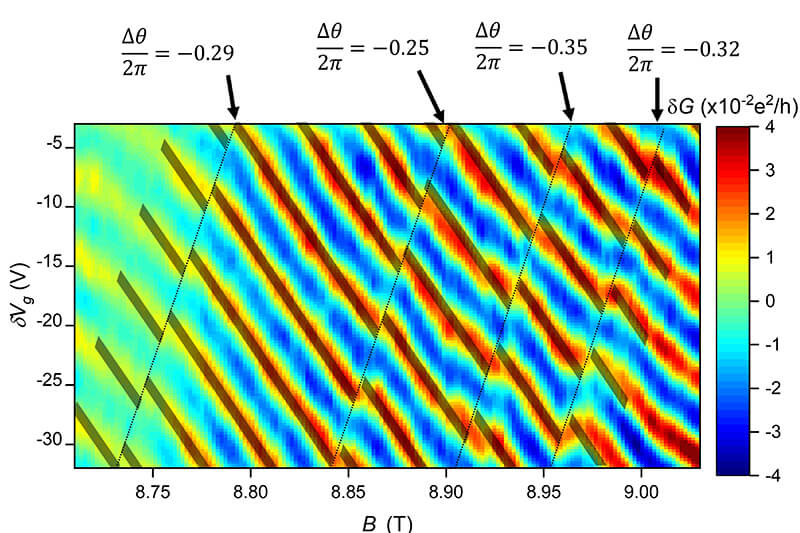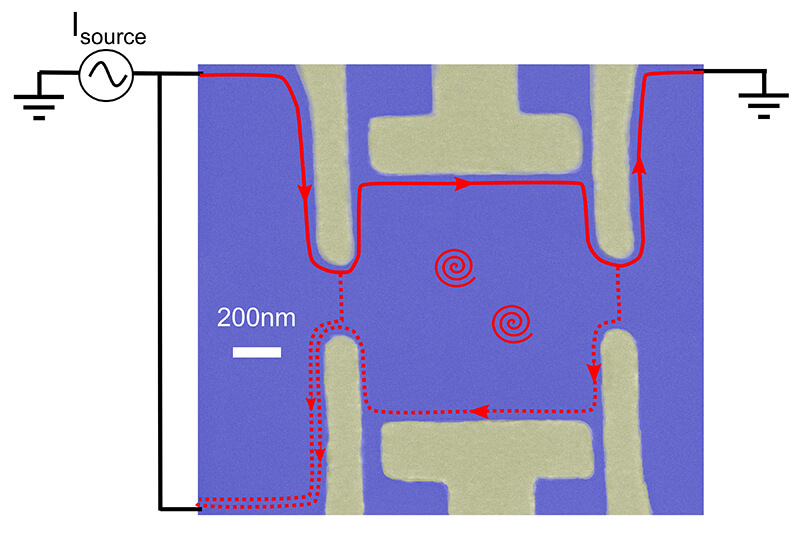
Posted on 09/04/2020 5:48:07 PM PDT by LibWhacker
Note to journalists: Journalists visiting campus should follow visitor health guidelines.

Experimental evidence of quasiparticles called anyons has been found by a team of scientists at Purdue University. Electrical interference in the experiment created a pattern which the researchers called a “pyjama plot”; jumps in the interference pattern were the signature of the presence of anyons. (Purdue University image/James Nakamura)
WEST LAFAYETTE, Ind. — New experimental evidence of a collective behavior of electrons to form "quasiparticles" called "anyons" has been reported by a team of scientists at Purdue University.
Anyons have characteristics not seen in other subatomic particles, including exhibiting fractional charge and fractional statistics that maintain a "memory" of their interactions with other quasiparticles by inducing quantum mechanical phase changes.
Postdoctoral research associate James Nakamura, with assistance from research group members Shuang Liang and Geoffrey Gardner, made the discovery while working in the laboratory of professor Michael Manfra. Manfra is a Distinguished Professor of Physics and Astronomy, Purdue's Bill and Dee O'Brien Chair Professor of Physics and Astronomy, professor of electrical and computer engineering, and professor of materials engineering. Although this work might eventually turn out to be relevant to the development of a quantum computer, for now, Manfra said, it is to be considered an important step in understanding the physics of quasiparticles.
A research paper on the discovery was published in this week's Nature Physics.
 Scientists at Purdue have announced new experimental evidence of a collective behavior of electrons to form "quasiparticles" called "anyons." The team was able to demonstrate this behavior by routing the electrons through a specific maze-like etched nanostructure in a nanoscale device called an interferometer. (Purdue University image/James Nakamura)
Scientists at Purdue have announced new experimental evidence of a collective behavior of electrons to form "quasiparticles" called "anyons." The team was able to demonstrate this behavior by routing the electrons through a specific maze-like etched nanostructure in a nanoscale device called an interferometer. (Purdue University image/James Nakamura) Nobel Prize-winning theoretical physicist Frank Wilczek, professor of physics at MIT, gave these quasiparticles the tongue-in-cheek name "anyon" due to their strange behavior because unlike other types of particles, they can adopt “any” quantum phase when their positions are exchanged.
Before the growing evidence of anyons in 2020, physicists had categorized particles in the known world into two groups: fermions and bosons. Electrons are an example of fermions, and photons, which make up light and radio waves, are bosons. One characteristic difference between fermions and bosons is how the particles act when they are looped, or braided, around each other. Fermions respond in one straightforward way, and bosons in another expected and straightforward way.
Anyons respond as if they have a fractional charge, and even more interestingly, create a nontrivial phase change as they braid around one another. This can give the anyons a type of "memory" of their interaction.
"Anyons only exist as collective excitations of electrons under special circumstances," Manfra said. “But they do have these demonstrably cool properties including fractional charge and fractional statistics. It is funny, because you think, 'How can they have less charge than the elementary charge of an electron?' But they do."
Manfra said that when bosons or fermions are exchanged, they generate a phase factor of either plus one or minus one, respectively.
"In the case of our anyons the phase generated by braiding was 2π/3," he said. “That's different than what's been seen in nature before."
Anyons display this behavior only as collective crowds of electrons, where many electrons behave as one under very extreme and specific conditions, so they are not thought to be found isolated in nature, Nakamura said.
"Normally in the world of physics, we think about fundamental particles, such as protons and electrons, and all of the things that make up the periodic table," he said. "But we study the existence of quasiparticles, which emerge from a sea of electrons that are placed in certain extreme conditions."
Because this behavior depends on the number of times the particles are braided, or looped, around each other, they are more robust in their properties than other quantum particles. This characteristic is said to be topological because it depends on the geometry of the system and may eventually lead to much more sophisticated anyon structures that could be used to build stable, topological quantum computers.
The team was able to demonstrate this behavior by routing the electrons through a specific maze-like etched nanostructure made of gallium arsenide and aluminum gallium arsenide. This device, called an interferometer, confined the electrons to move in a two-dimensional path. The device was cooled to within one-hundredth of a degree from absolute zero (10 millikelvin), and subjected to a powerful 9-Tesla magnetic field. The electrical resistance of the interferometer generated an interference pattern which the researchers called a “pyjama plot.” Jumps in the interference pattern were the signature of the presence of anyons.
"It is definitely one of the more complex and complicated things to be done in experimental physics," Chetan Nayak, theoretical physicist at the University of California, Santa Barbara told Science News.
Nakamura said the facilities at Purdue created the environment for this discovery to happen.
"We have the technology to grow the gallium arsenide semiconductor that's needed to realize our electron system. We have the nanofabrication facilities in the Birck Nanotechnology Center to make the interferometer, the device we used in our experiments. In the physics department, we have the ability to measure ultra-low temperatures and to create strong magnetic fields." he said. "So, we have all of the necessary components that allowed us to make this discovery all here at Purdue. That's a great thing about doing research here and why we've been able to make this progress."
Manfra said the next step in the quasiparticle frontier will involve building more complicated interferometers.
"In the new interferometers we will have the ability to control the location and number of quasiparticles in the chamber," he said. "Then we will be able to change the number of quasiparticles inside the interferometer on demand and change the interference pattern as we choose.”
Any bosons (light) you can shed on this subject will be greatly appreciated! :-)
The more we learn, the less we know.
...this, by the way, is mathematical...
My work disputes this.
So these Anyons can be one thing and look like another.
Sort of the transvestites of the quasiparticles.
Mine would too if I ever did any.
They identify as other kinds of quasiparticles.
“Normally in the world of physics, we think about fundamental particles, such as protons and electrons, and all of the things that make up the periodic table,” he said“
—————-
They start out with physics and then toss in chemistry.
That’s simply not fair. Or proper.
I've known this all along.
Voice sound activated universe
Don’t say that too loud. You might give some justification to all the trannies out there.
Well, there’s a lot of numbers at the top of the page.
And I see pie. It’s blue, so it must be blueberry pie.
Ah, yes. Al Gore predicted all of this years ago when he said “Global Warming will cause anyons to have characteristics not seen in other subatomic particles.”
Personally, I think Mr. Gore deserves a Nobel Prize in Physics to go along with his Nobel Peace Prize.
Physicists found a handful of dirt a hundred years ago and point out that one grain is different than the other. That’s not progress.
Stranger than I thought? Not a chance.
EXACTLY! Thank you. As a former math major, I often tell my friends not to fret it if they do not understand this stuff because in order to truly understand it, you have to be able to follow the math. Then and only then can you possibly grasp it. So don’t beat yourself up if you don’t get it. It doesn’t mean you’re dumb.
In my own case, I’m over the hill and far too old to even try to follow the math nowadays. Therefore, I’ll never truly understand it and can only make light of it.
They just need to look down between their quasiparticle legs to see what they are.
I think everything is probably a lot stranger than we CAN think.
We seem to learn a tiny bit, every generation, which slowly causes us to change our minds about some things - and this evolves our understanding in a manageable and not overwhelming way.
But every generation, despite the historical lessons of science and human error, still seems to think that it really UNDERSTANDS it all. (And that assumption has often caused us to make big mistakes...)
Life and Science are endlessly fascinating and full of rewarding opportunities.
Oh great! The electrons keeping less of their charge because they become part of the collective and ‘share’ a part of their charge is going to be the DemonRats/BernieBros/AOC/Hidin-Biden’s talking points that Socialism is the ‘better nature’.
Gag me. We can’t even keep our electrons free as individuals.
/sarc
Disclaimer: Opinions posted on Free Republic are those of the individual posters and do not necessarily represent the opinion of Free Republic or its management. All materials posted herein are protected by copyright law and the exemption for fair use of copyrighted works.